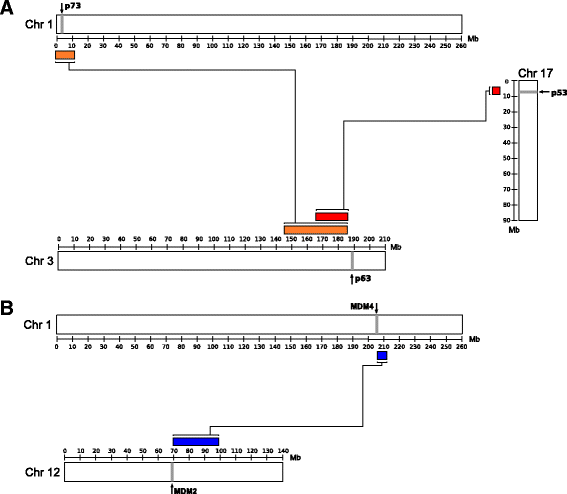Evolution of the p53-MDM2 pathway
- PMID: 28774266
- PMCID: PMC5543598
- DOI: 10.1186/s12862-017-1023-y
Evolution of the p53-MDM2 pathway
Abstract
Background: The p53 signalling pathway, which controls cell fate, has been extensively studied due to its prominent role in tumor development. The pathway includes the tumor supressor protein p53, its vertebrate paralogs p63 and p73, and their negative regulators MDM2 and MDM4. The p53/p63/p73-MDM system is ancient and can be traced in all extant animal phyla. Despite this, correct phylogenetic trees including both vertebrate and invertebrate species of the p53/p63/p73 and MDM families have not been published.
Results: Here, we have examined the evolution of the p53/p63/p73 protein family with particular focus on the p53/p63/p73 transactivation domain (TAD) and its co-evolution with the p53/p63/p73-binding domain (p53/p63/p73BD) of MDM2. We found that the TAD and p53/p63/p73BD share a strong evolutionary connection. If one of the domains of the protein is lost in a phylum, then it seems very likely to be followed by loss of function by the other domain as well, and due to the loss of function it is likely to eventually disappear. By focusing our phylogenetic analysis to p53/p63/p73 and MDM proteins from phyla that retain the interaction domains TAD and p53/p63/p73BD, we built phylogenetic trees of p53/p63/p73 and MDM based on both vertebrate and invertebrate species. The trees follow species evolution and contain a total number of 183 and 98 species for p53/p63/p73 and MDM, respectively. We also demonstrate that the p53/p63/p73 and MDM families result from whole genome duplications.
Conclusions: The signaling pathway of the TAD and p53/p63/p73BD in p53/p63/p73 and MDM, respectively, dates back to early metazoan time and has since then tightly co-evolved, or disappeared in distinct lineages.
Keywords: Co-evolution; MDM; Phylogeny; p53.
Conflict of interest statement
Ethics approval and consent to participate
Not applicable
Consent for publication
Not applicable
Competing interests
The authors declare that they have no competing interests.
Publisher’s Note
Springer Nature remains neutral with regard to jurisdictional claims in published maps and institutional affiliations.
Figures




References
MeSH terms
Substances
LinkOut - more resources
Full Text Sources
Other Literature Sources
Research Materials
Miscellaneous

